2007 KIA Sportage warning
[x] Cancel search: warningPage 326 of 350
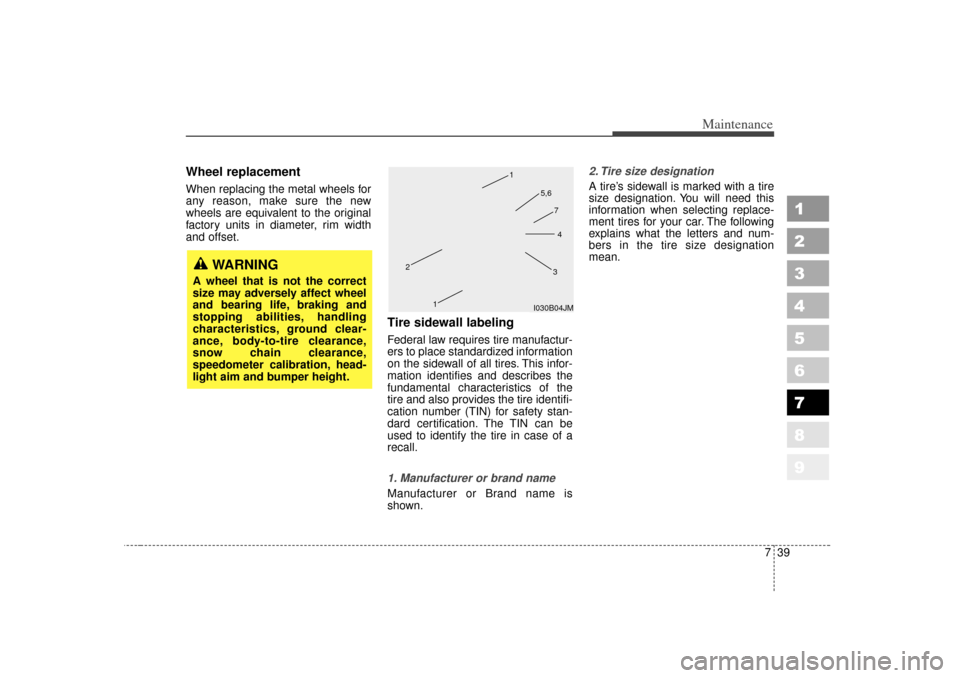
739
Maintenance
1
2
3
4
5
6
7
8
9
Wheel replacement When replacing the metal wheels for
any reason, make sure the new
wheels are equivalent to the original
factory units in diameter, rim width
and offset.
Tire sidewall labelingFederal law requires tire manufactur-
ers to place standardized information
on the sidewall of all tires. This infor-
mation identifies and describes the
fundamental characteristics of the
tire and also provides the tire identifi-
cation number (TIN) for safety stan-
dard certification. The TIN can be
used to identify the tire in case of a
recall.1. Manufacturer or brand nameManufacturer or Brand name is
shown.
2. Tire size designation A tire’s sidewall is marked with a tire
size designation. You will need this
information when selecting replace-
ment tires for your car. The following
explains what the letters and num-
bers in the tire size designation
mean.
WARNING
A wheel that is not the correct
size may adversely affect wheel
and bearing life, braking and
stopping abilities, handling
characteristics, ground clear-
ance, body-to-tire clearance,
snow chain clearance,
speedometer calibration, head-
light aim and bumper height.
I030B04JM
1
1
2
34
5,6
7
Page 328 of 350
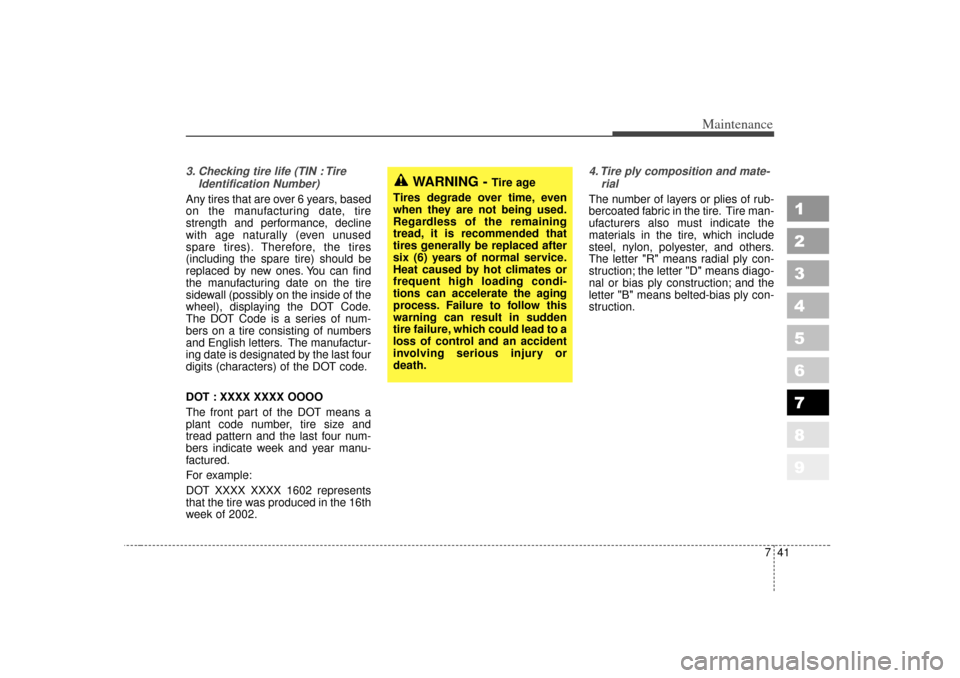
741
Maintenance
1
2
3
4
5
6
7
8
9
3. Checking tire life (TIN : TireIdentification Number) Any tires that are over 6 years, based
on the manufacturing date, tire
strength and performance, decline
with age naturally (even unused
spare tires). Therefore, the tires
(including the spare tire) should be
replaced by new ones. You can find
the manufacturing date on the tire
sidewall (possibly on the inside of the
wheel), displaying the DOT Code.
The DOT Code is a series of num-
bers on a tire consisting of numbers
and English letters. The manufactur-
ing date is designated by the last four
digits (characters) of the DOT code.
DOT : XXXX XXXX OOOO
The front part of the DOT means a
plant code number, tire size and
tread pattern and the last four num-
bers indicate week and year manu-
factured.
For example:
DOT XXXX XXXX 1602 represents
that the tire was produced in the 16th
week of 2002.
4. Tire ply composition and mate-rialThe number of layers or plies of rub-
bercoated fabric in the tire. Tire man-
ufacturers also must indicate the
materials in the tire, which include
steel, nylon, polyester, and others.
The letter "R" means radial ply con-
struction; the letter "D" means diago-
nal or bias ply construction; and the
letter "B" means belted-bias ply con-
struction.
WARNING -
Tire age
Tires degrade over time, even
when they are not being used.
Regardless of the remaining
tread, it is recommended that
tires generally be replaced after
six (6) years of normal service.
Heat caused by hot climates or
frequent high loading condi-
tions can accelerate the aging
process. Failure to follow this
warning can result in sudden
tire failure, which could lead to a
loss of control and an accident
involving serious injury or
death.
Page 330 of 350
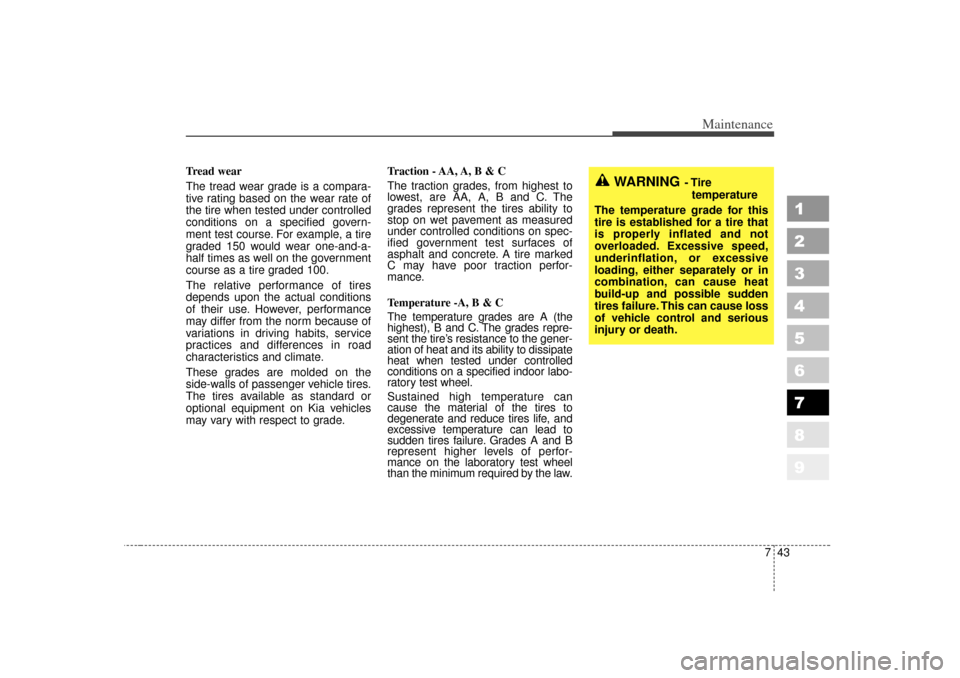
743
Maintenance
1
2
3
4
5
6
7
8
9
Tread wear
The tread wear grade is a compara-
tive rating based on the wear rate of
the tire when tested under controlled
conditions on a specified govern-
ment test course. For example, a tire
graded 150 would wear one-and-a-
half times as well on the government
course as a tire graded 100.
The relative performance of tires
depends upon the actual conditions
of their use. However, performance
may differ from the norm because of
variations in driving habits, service
practices and differences in road
characteristics and climate.
These grades are molded on the
side-walls of passenger vehicle tires.
The tires available as standard or
optional equipment on Kia vehicles
may vary with respect to grade.Traction - AA, A, B & C
The traction grades, from highest to
lowest, are AA, A, B and C. The
grades represent the tires ability to
stop on wet pavement as measured
under controlled conditions on spec-
ified government test surfaces of
asphalt and concrete. A tire marked
C may have poor traction perfor-
mance.
Temperature -A, B & C
The temperature grades are A (the
highest), B and C. The grades repre-
sent the tire’s resistance to the gener-
ation of heat and its ability to dissipate
heat when tested under controlled
conditions on a specified indoor labo-
ratory test wheel.
Sustained high temperature can
cause the material of the tires to
degenerate and reduce tires life, and
excessive temperature can lead to
sudden tires failure. Grades A and B
represent higher levels of perfor-
mance on the laboratory test wheel
than the minimum required by the law.
WARNING
- Tire
temperature
The temperature grade for this
tire is established for a tire that
is properly inflated and not
overloaded. Excessive speed,
underinflation, or excessive
loading, either separately or in
combination, can cause heat
build-up and possible sudden
tires failure. This can cause loss
of vehicle control and serious
injury or death.
Page 337 of 350
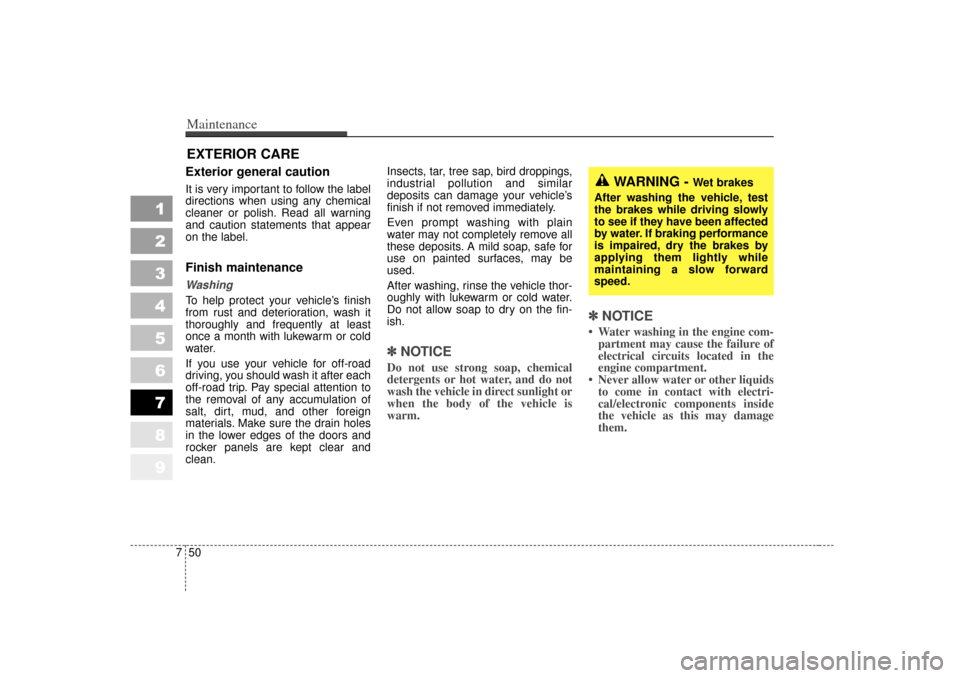
Maintenance50
7
1
2
3
4
5
6
7
8
9
EXTERIOR CARE Exterior general caution It is very important to follow the label
directions when using any chemical
cleaner or polish. Read all warning
and caution statements that appear
on the label.Finish maintenanceWashing To help protect your vehicle’s finish
from rust and deterioration, wash it
thoroughly and frequently at least
once a month with lukewarm or cold
water.
If you use your vehicle for off-road
driving, you should wash it after each
off-road trip. Pay special attention to
the removal of any accumulation of
salt, dirt, mud, and other foreign
materials. Make sure the drain holes
in the lower edges of the doors and
rocker panels are kept clear and
clean. Insects, tar, tree sap, bird droppings,
industrial pollution and similar
deposits can damage your vehicle’s
finish if not removed immediately.
Even prompt washing with plain
water may not completely remove all
these deposits. A mild soap, safe for
use on painted surfaces, may be
used.
After washing, rinse the vehicle thor-
oughly with lukewarm or cold water.
Do not allow soap to dry on the fin-
ish.
✽ ✽
NOTICEDo not use strong soap, chemical
detergents or hot water, and do not
wash the vehicle in direct sunlight or
when the body of the vehicle is
warm.
✽ ✽NOTICE• Water washing in the engine com-
partment may cause the failure of
electrical circuits located in the
engine compartment.
• Never allow water or other liquids to come in contact with electri-
cal/electronic components inside
the vehicle as this may damage
them.
WARNING -
Wet brakes
After washing the vehicle, test
the brakes while driving slowly
to see if they have been affected
by water. If braking performance
is impaired, dry the brakes by
applying them lightly while
maintaining a slow forward
speed.
Page 339 of 350
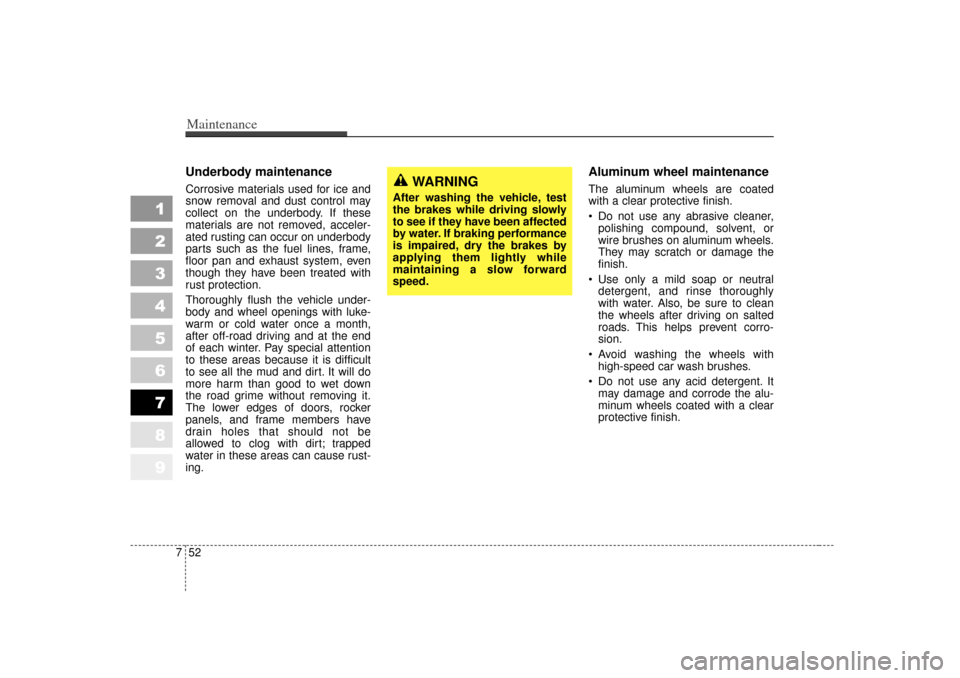
Maintenance52
7
1
2
3
4
5
6
7
8
9
Underbody maintenanceCorrosive materials used for ice and
snow removal and dust control may
collect on the underbody. If these
materials are not removed, acceler-
ated rusting can occur on underbody
parts such as the fuel lines, frame,
floor pan and exhaust system, even
though they have been treated with
rust protection.
Thoroughly flush the vehicle under-
body and wheel openings with luke-
warm or cold water once a month,
after off-road driving and at the end
of each winter. Pay special attention
to these areas because it is difficult
to see all the mud and dirt. It will do
more harm than good to wet down
the road grime without removing it.
The lower edges of doors, rocker
panels, and frame members have
drain holes that should not be
allowed to clog with dirt; trapped
water in these areas can cause rust-
ing.
Aluminum wheel maintenance The aluminum wheels are coated
with a clear protective finish.
Do not use any abrasive cleaner,
polishing compound, solvent, or
wire brushes on aluminum wheels.
They may scratch or damage the
finish.
Use only a mild soap or neutral detergent, and rinse thoroughly
with water. Also, be sure to clean
the wheels after driving on salted
roads. This helps prevent corro-
sion.
Avoid washing the wheels with high-speed car wash brushes.
Do not use any acid detergent. It may damage and corrode the alu-
minum wheels coated with a clear
protective finish.
WARNING
After washing the vehicle, test
the brakes while driving slowly
to see if they have been affected
by water. If braking performance
is impaired, dry the brakes by
applying them lightly while
maintaining a slow forward
speed.
Page 348 of 350
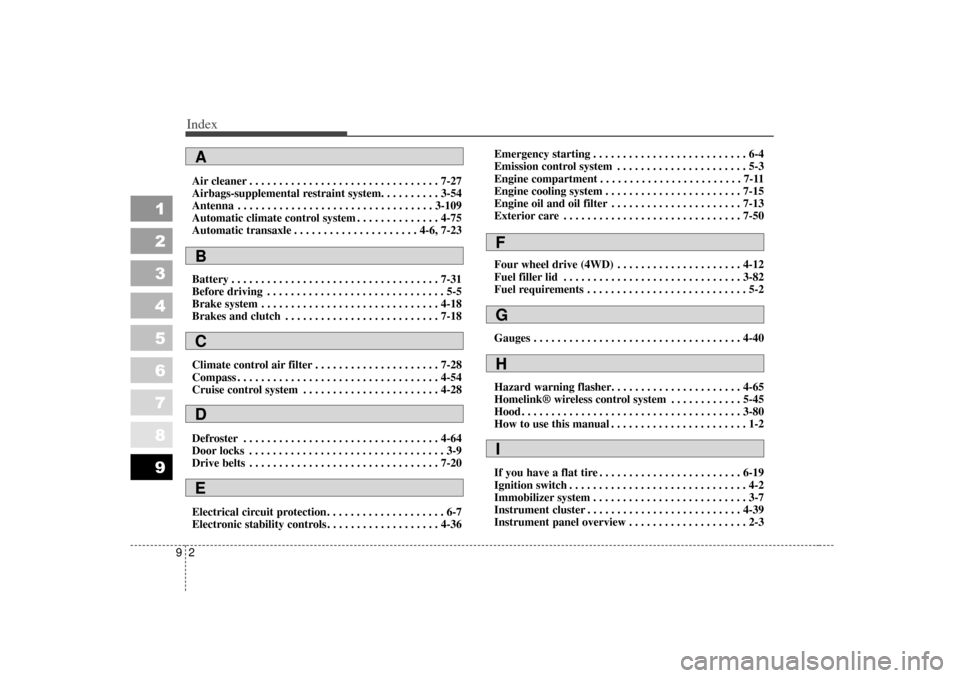
Index29
1
2
3
4
5
6
7
8
9
Air cleaner . . . . . . . . . . . . . . . . . . . . . . . . . . . . . . . . 7-27
Airbags-supplemental restraint system. . . . . . . . . . 3-54
Antenna . . . . . . . . . . . . . . . . . . . . . . . . . . . . . . . . . 3-109
Automatic climate control system . . . . . . . . . . . . . . 4-75
Automatic transaxle . . . . . . . . . . . . . . . . . . . . . 4-6, 7-23
Battery . . . . . . . . . . . . . . . . . . . . . . . . . . . . . . . . . . . 7-\
31
Before driving . . . . . . . . . . . . . . . . . . . . . . . . . . . . . . 5-5
Brake system . . . . . . . . . . . . . . . . . . . . . . . . . . . . . . 4-18
Brakes and clutch . . . . . . . . . . . . . . . . . . . . . . . . . . 7-18
Climate control air filter . . . . . . . . . . . . . . . . . . . . . 7-28
Compass . . . . . . . . . . . . . . . . . . . . . . . . . . . . . . . . . . 4-54\
Cruise control system . . . . . . . . . . . . . . . . . . . . . . . 4-28
Defroster . . . . . . . . . . . . . . . . . . . . . . . . . . . . . . . . . 4-64
Door locks . . . . . . . . . . . . . . . . . . . . . . . . . . . . . . . . . 3-9
Drive belts . . . . . . . . . . . . . . . . . . . . . . . . . . . . . . . . 7-20
Electrical circuit protection. . . . . . . . . . . . . . . . . . . . 6-7
Electronic stability controls . . . . . . . . . . . . . . . . . . . 4-36Emergency starting . . . . . . . . . . . . . . . . . . . . . . . . . . 6-4
Emission control system . . . . . . . . . . . . . . . . . . . . . . 5-3
Engine compartment . . . . . . . . . . . . . . . . . . . . . . . . 7-11
Engine cooling system . . . . . . . . . . . . . . . . . . . . . . . 7-15
Engine oil and oil filter . . . . . . . . . . . . . . . . . . . . . . 7-13
Exterior care . . . . . . . . . . . . . . . . . . . . . . . . . . . . . . 7-50
Four wheel drive (4WD) . . . . . . . . . . . . . . . . . . . . . 4-12
Fuel filler lid . . . . . . . . . . . . . . . . . . . . . . . . . . . . . . 3-82
Fuel requirements . . . . . . . . . . . . . . . . . . . . . . . . . . . 5-2
Gauges . . . . . . . . . . . . . . . . . . . . . . . . . . . . . . . . . . . 4-\
40
Hazard warning flasher. . . . . . . . . . . . . . . . . . . . . . 4-65
Homelink® wireless control system . . . . . . . . . . . . 5-45
Hood . . . . . . . . . . . . . . . . . . . . . . . . . . . . . . . . . . . . \
. 3-80
How to use this manual . . . . . . . . . . . . . . . . . . . . . . . 1-2
If you have a flat tire . . . . . . . . . . . . . . . . . . . . . . . . 6-19
Ignition switch . . . . . . . . . . . . . . . . . . . . . . . . . . . . . . 4-2
Immobilizer system . . . . . . . . . . . . . . . . . . . . . . . . . . 3-7
Instrument cluster . . . . . . . . . . . . . . . . . . . . . . . . . . 4-39
Instrument panel overview . . . . . . . . . . . . . . . . . . . . 2-3ABCDE
GFHI
Page 349 of 350
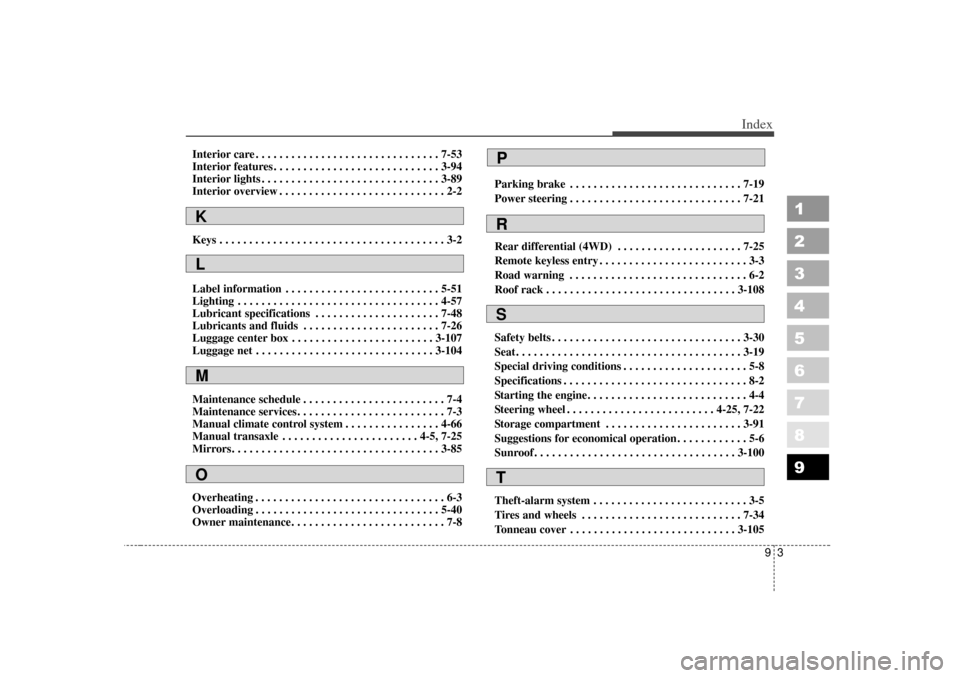
93
1
2
3
4
5
6
7
8
9
Index
Interior care . . . . . . . . . . . . . . . . . . . . . . . . . . . . . . . 7-53
Interior features . . . . . . . . . . . . . . . . . . . . . . . . . . . . 3-94
Interior lights . . . . . . . . . . . . . . . . . . . . . . . . . . . . . . 3-89
Interior overview . . . . . . . . . . . . . . . . . . . . . . . . . . . . 2-2
Keys . . . . . . . . . . . . . . . . . . . . . . . . . . . . . . . . . . . . \
. . 3-2
Label information . . . . . . . . . . . . . . . . . . . . . . . . . . 5-51
Lighting . . . . . . . . . . . . . . . . . . . . . . . . . . . . . . . . . . 4-57\
Lubricant specifications . . . . . . . . . . . . . . . . . . . . . 7-48
Lubricants and fluids . . . . . . . . . . . . . . . . . . . . . . . 7-26
Luggage center box . . . . . . . . . . . . . . . . . . . . . . . . 3-107
Luggage net . . . . . . . . . . . . . . . . . . . . . . . . . . . . . . 3-104
Maintenance schedule . . . . . . . . . . . . . . . . . . . . . . . . 7-4
Maintenance services. . . . . . . . . . . . . . . . . . . . . . . . . 7-3
Manual climate control system . . . . . . . . . . . . . . . . 4-66
Manual transaxle . . . . . . . . . . . . . . . . . . . . . . . 4-5, 7-25
Mirrors. . . . . . . . . . . . . . . . . . . . . . . . . . . . . . . . . . . 3-\
85
Overheating . . . . . . . . . . . . . . . . . . . . . . . . . . . . . . . . 6-3
Overloading . . . . . . . . . . . . . . . . . . . . . . . . . . . . . . . 5-40
Owner maintenance. . . . . . . . . . . . . . . . . . . . . . . . . . 7-8Parking brake . . . . . . . . . . . . . . . . . . . . . . . . . . . . . 7-19
Power steering . . . . . . . . . . . . . . . . . . . . . . . . . . . . . 7-21
Rear differential (4WD) . . . . . . . . . . . . . . . . . . . . . 7-25
Remote keyless entry . . . . . . . . . . . . . . . . . . . . . . . . . 3-3
Road warning . . . . . . . . . . . . . . . . . . . . . . . . . . . . . . 6-2
Roof rack . . . . . . . . . . . . . . . . . . . . . . . . . . . . . . . . 3-108
Safety belts . . . . . . . . . . . . . . . . . . . . . . . . . . . . . . . . 3-30
Seat . . . . . . . . . . . . . . . . . . . . . . . . . . . . . . . . . . . . \
. . 3-19
Special driving conditions . . . . . . . . . . . . . . . . . . . . . 5-8
Specifications . . . . . . . . . . . . . . . . . . . . . . . . . . . . . . . 8-2
Starting the engine. . . . . . . . . . . . . . . . . . . . . . . . . . . 4-4
Steering wheel . . . . . . . . . . . . . . . . . . . . . . . . . 4-25, 7-22
Storage compartment . . . . . . . . . . . . . . . . . . . . . . . 3-91
Suggestions for economical operation . . . . . . . . . . . . 5-6
Sunroof . . . . . . . . . . . . . . . . . . . . . . . . . . . . . . . . . . 3-10\
0
Theft-alarm system . . . . . . . . . . . . . . . . . . . . . . . . . . 3-5
Tires and wheels . . . . . . . . . . . . . . . . . . . . . . . . . . . 7-34
Tonneau cover . . . . . . . . . . . . . . . . . . . . . . . . . . . . 3-105KLMO
PRST
Page 350 of 350
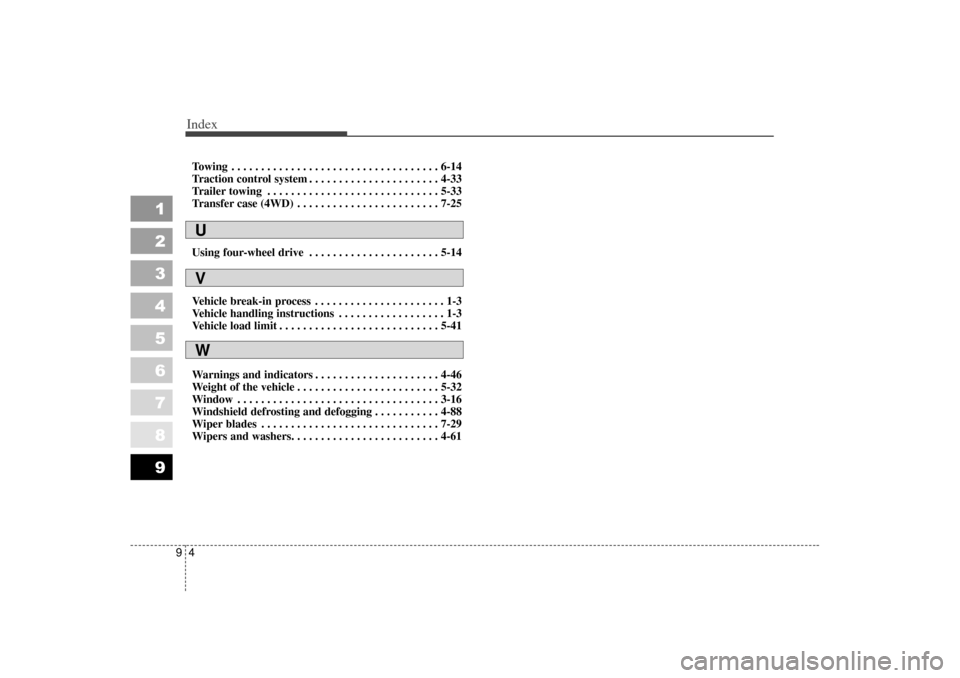
Index49
1
2
3
4
5
6
7
8
9
Towing . . . . . . . . . . . . . . . . . . . . . . . . . . . . . . . . . . . 6-\
14
Traction control system . . . . . . . . . . . . . . . . . . . . . . 4-33
Trailer towing . . . . . . . . . . . . . . . . . . . . . . . . . . . . . 5-33
Transfer case (4WD) . . . . . . . . . . . . . . . . . . . . . . . . 7-25
Using four-wheel drive . . . . . . . . . . . . . . . . . . . . . . 5-14
Vehicle break-in process . . . . . . . . . . . . . . . . . . . . . . 1-3
Vehicle handling instructions . . . . . . . . . . . . . . . . . . 1-3
Vehicle load limit . . . . . . . . . . . . . . . . . . . . . . . . . . . 5-41
Warnings and indicators . . . . . . . . . . . . . . . . . . . . . 4-46
Weight of the vehicle . . . . . . . . . . . . . . . . . . . . . . . . 5-32
Window . . . . . . . . . . . . . . . . . . . . . . . . . . . . . . . . . . 3-16\
Windshield defrosting and defogging . . . . . . . . . . . 4-88
Wiper blades . . . . . . . . . . . . . . . . . . . . . . . . . . . . . . 7-29
Wipers and washers. . . . . . . . . . . . . . . . . . . . . . . . . 4-61UVW